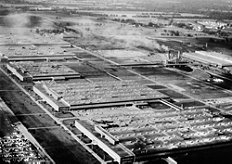Shipping Outsourced Jobs Back Home
When General Electric's Appliance Park was first conceived, more than likely its designers hoped it would be the embodiment of American ingenuity and prosperity. Unfortunately, they were wrong. For the past decade, the park, a once bustling mini-city with mile-long parking lots and its own traffic light system, has been as barren as the US manufacturing economy.
 At its inception, the park's monolithic scale reflected a booming industry. Designed in 1951, the complex had its own fire department, its own power plant, even its own zip code. By 1955, it housed 16,000 employees, a number that would peak at 23,000 in 1973. In the midst of the blooming consumer economy in the US, GE was a paragon of manufacturing ambition.
At its inception, the park's monolithic scale reflected a booming industry. Designed in 1951, the complex had its own fire department, its own power plant, even its own zip code. By 1955, it housed 16,000 employees, a number that would peak at 23,000 in 1973. In the midst of the blooming consumer economy in the US, GE was a paragon of manufacturing ambition.
But by the 1980's, it was clear that GE's vitality was dwindling, and by 1984 the park employed fewer workers than it did in 1955. Finally, after a failed attempt to sell GE's entire business along with the Appliance Park, the number of time-card employees bottomed out to 1,863 in 2011.
And yet, only a year later something curious and hopeful came out of Appliance Park's Building 2: a new assembly line. Specifically, the first assembly line in 55 years, restoring some life into a building that had been largely dormant for 14 years. Thirty-nine days later, a second new assembly line appeared in Building 5, and a new assembly line for Building 3 is now under construction. These new assembly lines will produce appliances from state-of-the-art refrigerators to low-energy water heaters.
But perhaps more intriguing than GE's decision to revive the dwindling park was CEO Jeffrey Inmelt's assertion that outsourcing is “quickly becoming mostly outdated as a business model for GE appliances.” Coming a mere four years after Inmelt attempted to sell Appliance Park, it would be easy to label the statement hypocritical – until you take into account the CEO's $800 million investment toward bringing GE manufacturing back home.
Given spikes in cargo-ship fuel costs, the natural gas boom in the US, and rising wages for Chinese workers, the logic of Inmelt's position begins to make all kinds of sense.
And GE isn't the only company to surf in on what they perceive as the industry's changing tides; Apple today announced on NBC's “Rock Center” that one of their Mac lines will be manufactured exclusively in the US, starting next year.
So perhaps Inmelt's position has a lot more supporting it than optimism. If his intuition proves true, it could mean lasting, beneficial changes for the US manufacturing industry.
Full story at TheAtlantic










